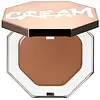What's inside
What's inside
 Key Ingredients
Key Ingredients

 Benefits
Benefits

 Concerns
Concerns

 Ingredients Side-by-side
Ingredients Side-by-side

Mica
Cosmetic ColorantSynthetic Fluorphlogopite
CI 77891
Cosmetic ColorantCI 77491
Cosmetic ColorantOctyldodecanol
EmollientDimethicone
EmollientMagnesium Stearate
Cosmetic ColorantCI 77163
Cosmetic ColorantKaolin
AbrasiveDimethicone/Divinyldimethicone/Silsesquioxane Crosspolymer
HumectantEthylhexyl Palmitate
EmollientSynthetic Wax
AbrasiveTriethylhexanoin
MaskingPolyisobutene
Tridecyl Trimellitate
EmollientCI 77499
Cosmetic ColorantEthylhexylglycerin
Skin ConditioningPhenoxyethanol
PreservativeBis-Diglyceryl Polyacyladipate-2
EmollientCopernicia Cerifera Cera
EmollientTin Oxide
AbrasiveMica, Synthetic Fluorphlogopite, CI 77891, CI 77491, Octyldodecanol, Dimethicone, Magnesium Stearate, CI 77163, Kaolin, Dimethicone/Divinyldimethicone/Silsesquioxane Crosspolymer, Ethylhexyl Palmitate, Synthetic Wax, Triethylhexanoin, Polyisobutene, Tridecyl Trimellitate, CI 77499, Ethylhexylglycerin, Phenoxyethanol, Bis-Diglyceryl Polyacyladipate-2, Copernicia Cerifera Cera, Tin Oxide
Octyldodecanol
EmollientIsononyl Isononanoate
EmollientCaprylic/Capric Triglyceride
MaskingSynthetic Fluorphlogopite
Pentaerythrityl Tetraisostearate
EmollientDicalcium Phosphate
AbrasiveSynthetic Wax
AbrasivePolyethylene
AbrasiveBis-Diglyceryl Polyacyladipate-2
EmollientSilica Silylate
EmollientNylon-12
Mica
Cosmetic ColorantCandelilla Cera
EmollientDisteardimonium Hectorite
StabilisingTocopheryl Acetate
AntioxidantPentaerythrityl Tetra-Di-T-Butyl Hydroxyhydrocinnamate
AntioxidantTalc
AbrasiveBHT
AntioxidantIron Oxides
CI 42090
Cosmetic ColorantCI 77891
Cosmetic ColorantOctyldodecanol, Isononyl Isononanoate, Caprylic/Capric Triglyceride, Synthetic Fluorphlogopite, Pentaerythrityl Tetraisostearate, Dicalcium Phosphate, Synthetic Wax, Polyethylene, Bis-Diglyceryl Polyacyladipate-2, Silica Silylate, Nylon-12, Mica, Candelilla Cera, Disteardimonium Hectorite, Tocopheryl Acetate, Pentaerythrityl Tetra-Di-T-Butyl Hydroxyhydrocinnamate, Talc, BHT, Iron Oxides, CI 42090, CI 77891
Ingredients Explained
These ingredients are found in both products.
Ingredients higher up in an ingredient list are typically present in a larger amount.
This ingredient is lipid-based synthetic skin-conditioning agent derived from adipic acid and a mixture of fatty acids. It is often called a lanolin substitute.
As an emollient, it helps soften and hydrate the skin. Emollients create a barrier on the skin to trap moisture in.
Due to its fatty acid base, it may not be Malassezia folliculitis safe.
Learn more about Bis-Diglyceryl Polyacyladipate-2Ci 77891 is a white pigment from Titanium dioxide. It is naturally found in minerals such as rutile and ilmenite.
It's main function is to add a white color to cosmetics. It can also be mixed with other colors to create different shades.
Ci 77891 is commonly found in sunscreens due to its ability to block UV rays.
Learn more about CI 77891Mica is a naturally occurring mineral used to add shimmer and color in cosmetics. It can also help improve the texture of a product or give it an opaque, white/silver color.
Serecite is the name for very fine but ragged grains of mica.
This ingredient is often coated with metal oxides like titanium dioxide. Trace amounts of heavy metals may be found in mica, but these metals are not harmful in our personal products.
Mica has been used since prehistoric times throughout the world. Ancient Egyptian, Indian, Greek, Roman, Aztec, and Chinese civilizations have used mica.
Learn more about MicaOctyldodecanol is a fatty alcohol. It is primarily used to enhance the texture of products.
As an emulsifier, Octyldodecanol helps prevent the oils and waters from separating. It also prevents ingredients from creating foam when shaken.
Octyldodecanol is created by reducing fatty acid to an alcohol.
Due to its high molecular weight, it does not get absorbed into the skin.
Learn more about OctyldodecanolSynthetic Fluorphlogopite is the synthethic version of mica. It consists of fluorine, aluminum and silicate.
Synthetic Fluorphlogopite is used to add volume to products.
It is considered non-irritating on the skin.
Learn more about Synthetic FluorphlogopiteSynthetic Wax is created from fossil fuels such as natural gas. It is used to enhance texture, adjust pH, and as an occlusive.
It may also be used as an abrasive ingredient to exfoliate the skin.
Synthetic Wax may not be fungal acne safe.
Learn more about Synthetic Wax